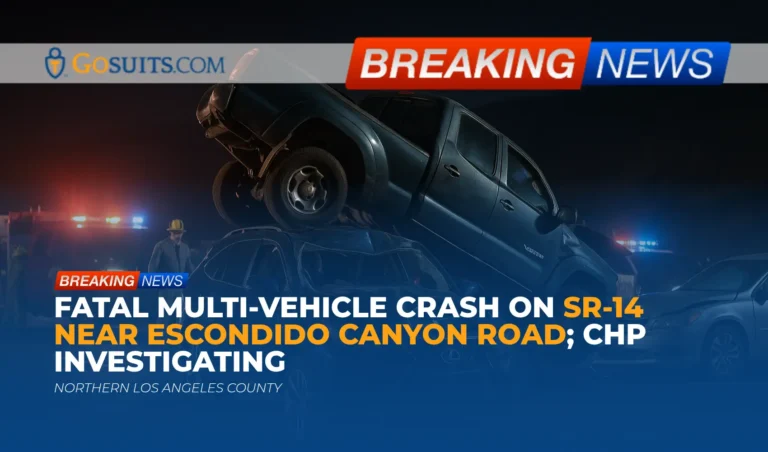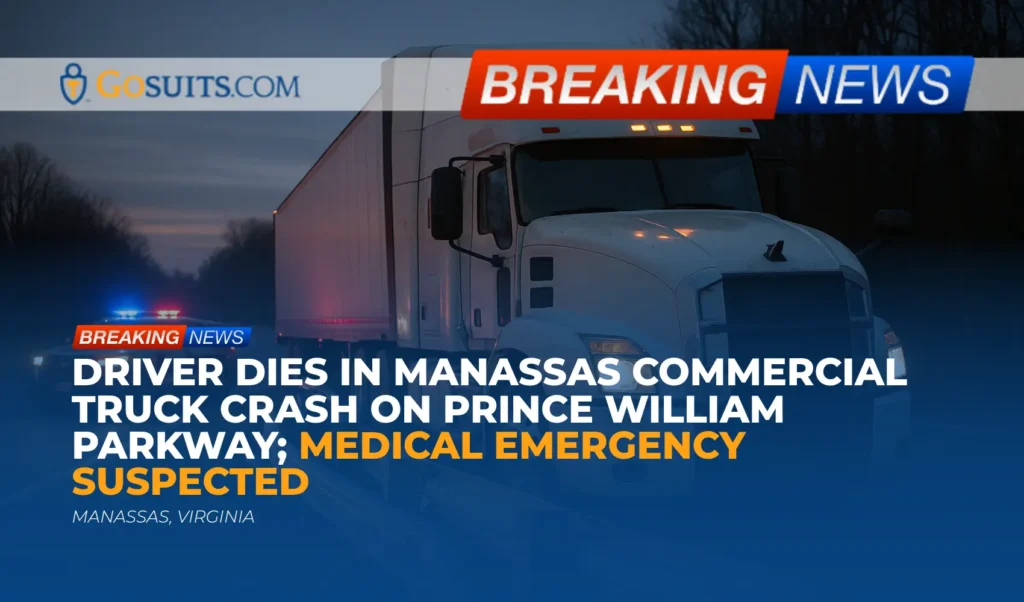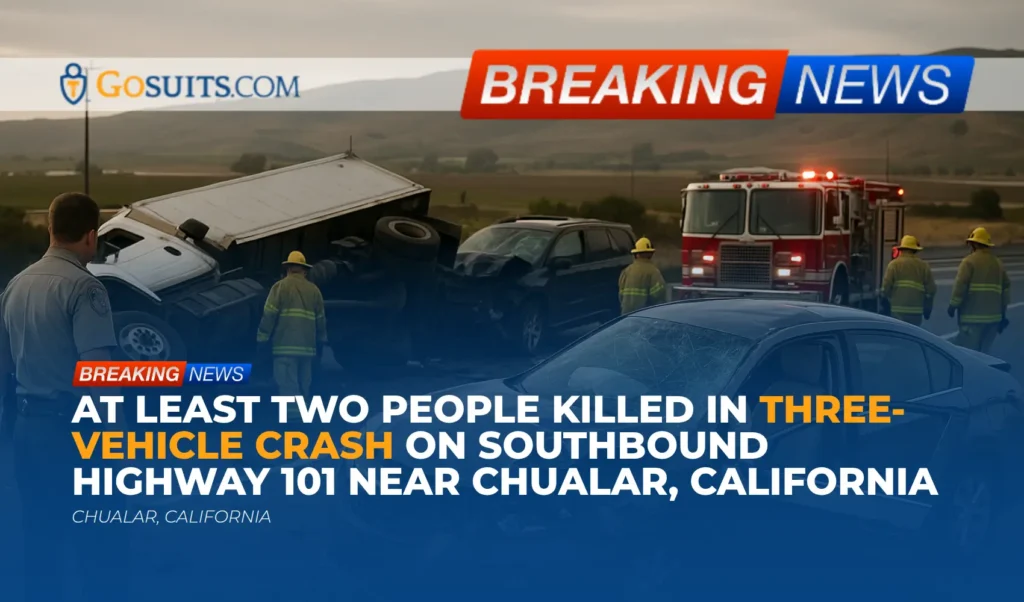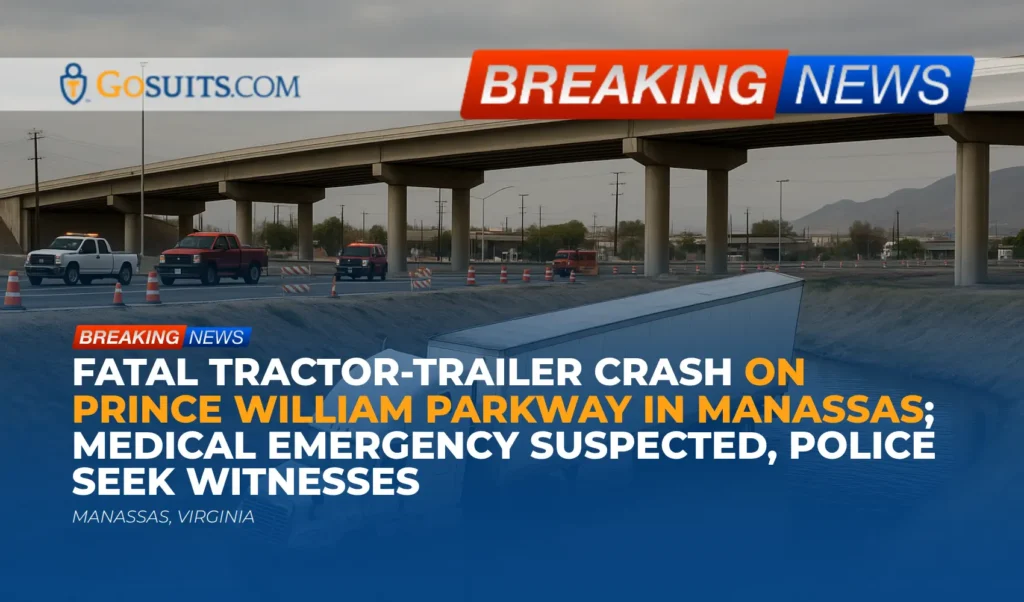- What happened on SR-14 near Escondido Canyon Road
- Location and jurisdiction: SR-14 and Escondido Canyon Road explained
- What investigators typically examine in a multi-vehicle freeway fatality
- Immediate steps that help after a serious or fatal crash
- How to obtain official records: collision report, coroner records, and certificates
- Rights after a fatal California crash: wrongful death and survival actions
- Potential civil liability and insurance issues in chain-reaction crashes
- Preserving crucial evidence early
- Safety context and data for multi-vehicle freeway collisions
- Practical support and public information resources
- Commentary from Gosuits Escondido, CA Personal Injury Attorney
- Why taking timely action matters now
What happened on SR-14 near Escondido Canyon Road
According to information reported for the public record, one person was killed in a multi-vehicle crash on northbound State Route 14 near Escondido Canyon Road on Friday night, October 12, 2025, at around 9:27 p.m. The California Highway Patrol responded to the scene. Vehicles reported included a blue Lexus SUV, a green Toyota Tacoma, and at least one additional vehicle. One vehicle overturned and another came to rest on top of it. Fire personnel, towing services, and CHP officers responded, and one fatality was confirmed at the scene. The coroner was notified, and investigators are examining the cause. Identity details have not been released at the time of this writing.
When official agencies share new, verified information, it can clarify factors such as traffic speeds, lane positions, evasive maneuvers, impairment screening, lighting, weather, and any mechanical or roadway issues. Until then, it is appropriate to avoid speculation and rely on official updates.
Location and jurisdiction: SR-14 and Escondido Canyon Road explained
The crash location described is on State Route 14 near Escondido Canyon Road, a corridor commonly associated with northern Los Angeles County. Despite the similar name, Escondido Canyon Road is distinct from the City of Escondido in San Diego County. On freeway matters such as SR-14, the California Highway Patrol is the primary investigating agency. Depending on the precise mile marker of the incident, coroner jurisdiction is likely the county in which the collision occurred.
Because jurisdiction affects which office issues collision reports and coroner records, a helpful first step is to verify the investigating CHP Area Office and the county coroner responsible for this location. For SR-14 near Escondido Canyon Road, CHP’s Newhall Area commonly patrols this stretch of freeway. You can locate CHP offices by region and confirm which office handled the report through the CHP website.
Public resources to verify jurisdiction and travel conditions include:
- CHP Newhall Area Office
- Caltrans QuickMap for live closure and incident information
What investigators typically examine in a multi-vehicle freeway fatality
In multi-vehicle freeway crashes, investigators generally assess a combination of human, vehicle, and environmental factors. Their analysis can include:
- Scene evidence such as lane markings, yaw marks, gouges, fluid trails, and debris fields that help reconstruct impact points and vehicle movements before and after collision.
- Vehicle inspections including crush profiles, airbag deployment, lighting, tires, brakes, and potential mechanical failures. Many modern vehicles store pre-crash data in an Event Data Recorder (EDR), which can capture speed, throttle, braking, and seat belt status seconds before impact. See federal EDR information at the eCFR (49 CFR Part 563).
- Driver factors such as distraction, fatigue, impairment screening, medical events, and driver licensing status.
- Environmental factors including lighting, weather, roadway design, signage, work zones, and visibility.
- Witness statements and media like dashcam footage, nearby business cameras, and 911 call timelines.
The CHP collision report determines preliminary findings. Final determinations, especially in fatal cases, can incorporate coroner findings and vehicle data downloads.
Immediate steps that help after a serious or fatal crash
In the immediate aftermath of a severe or fatal freeway crash, it is normal to feel overwhelmed. Safety, documentation, and careful communication can make a meaningful difference for everyone affected. The following steps are general information, not a substitute for individual guidance:
- Prioritize safety and medical care. If present at the scene and able, move to a safe location and call 911.
- Document what you can. Photographs of lanes, vehicles, debris, skid marks, license plates, and the general scene can be valuable later. Note the time, weather, and lighting.
- Identify potential witnesses. Names and contact details of bystanders who saw events unfold can be hard to gather after the fact.
- Avoid making recorded statements to insurers before consulting an attorney. What is said early can be used later, sometimes out of context. A brief, general notification to your own insurer is typically required by your policy, but it is prudent to seek a free consultation first to understand rights and obligations.
- Preserve vehicles and property. Do not authorize destruction or salvage of involved vehicles until you understand how that may affect evidence preservation.
- Seek support. Serious crashes are traumatic. Asking for help from trusted people and professionals is a strong step toward stability.
How to obtain official records: collision report, coroner records, and certificates
CHP collision report
The California Highway Patrol collision report is a cornerstone document. California law limits who may obtain a full report, generally to involved parties and their legal representatives. See California Vehicle Code section 20012.
Tips:
- Have details ready: date/time, highway, nearest cross street (Escondido Canyon Road), direction of travel, and involved vehicle information if known.
- Confirm the correct CHP Area Office handling the report (for SR-14 near Escondido Canyon Road, this is often the CHP Newhall Area).
Coroner and autopsy records
In fatal cases, the county medical examiner-coroner with jurisdiction will manage identification and determine the medical cause of death. For SR-14 near Escondido Canyon Road, this is commonly the Los Angeles County Medical Examiner. If a crash took place within San Diego County, then the San Diego County Medical Examiner would have jurisdiction. Because this incident references Escondido Canyon Road on SR-14, confirming the responsible county office is essential.
Each county sets policies for who can receive autopsy and investigation reports. Next of kin and legal representatives are typically eligible. Processing times can vary based on pending tests and case complexity.
Death certificates
Certified copies of death certificates are issued through the county recorder in the county of death. For collisions in northern Los Angeles County, certificates are generally obtained through Los Angeles County Registrar-Recorder/County Clerk.
Traffic information and maps
For road closures, detours, and incident markers, Caltrans QuickMap provides near real-time information.
Rights after a fatal California crash: wrongful death and survival actions
When a life is lost in a collision, California law provides civil pathways for family members and an estate to seek accountability and compensation-related relief. These pathways are distinct and may both apply, depending on the facts.
Wrongful death
A wrongful death claim seeks to address losses suffered by eligible surviving family members, such as loss of support, companionship, and certain expenses. The California Code of Civil Procedure recognizes who may bring these claims.
Survival action
A survival action belongs to the decedent’s estate and addresses certain damages the person could have claimed if they had survived, such as medical expenses and, in appropriate circumstances, property damage.

Time limits
California generally allows two years to file a wrongful death or personal injury lawsuit arising from a vehicular collision. It is important to consult the actual statutory language and obtain legal guidance specific to the facts.
Different, shorter deadlines can apply if a public entity may be responsible for a dangerous condition or other negligence. In those situations, a government claim typically must be presented within six months of the incident, with strict service and content rules.
Because statutes and exceptions are complex, obtaining a free consultation early can help avoid missed deadlines or unintentional waivers.
Potential civil liability and insurance issues in chain-reaction crashes
Multi-vehicle freeway crashes often involve multiple layers of potential responsibility. Understanding how fault and insurance coverage interact is important for families and injured survivors.
Comparative fault
California follows a pure comparative negligence system. Fault can be apportioned among multiple drivers, and a claimant’s recovery may be reduced by their percentage of responsibility. In chain-reaction settings, investigators may analyze who initiated the sequence, whether a following driver was maintaining a safe distance, and whether sudden hazards were reasonably avoidable.
Third parties and vicarious liability
If any vehicle was being driven for work, an employer may be responsible for the acts of its employee occurring within the scope of employment. Commercial policies generally carry higher liability limits than personal policies, which can affect available coverage. Ownership issues, permissive use, or negligent entrustment may also be considered.
Roadway conditions and public entity liability
In rare situations, visibility problems, missing or inadequate signage, or design/maintenance issues can contribute to a crash. Claims involving roadway conditions or construction zones may implicate public entities or contractors. These matters involve special claim procedures and shorter deadlines. See the six-month government claim deadline noted above.
Insurance coverage considerations
- Liability limits. California sets minimum auto liability insurance requirements. As of 2025, minimum limits are higher than in prior years. State resources explain financial responsibility requirements for drivers. See California DMV’s insurance information page for current requirements.
- Uninsured/Underinsured Motorist (UM/UIM). UM/UIM coverage on one’s own policy can be an important source of recovery when at-fault drivers have limited insurance.
- MedPay. Some policies include medical payments coverage regardless of fault, which can help with immediate medical or funeral expenses up to policy limits.
- Multiple policies. Coverage may be available from several sources, including at-fault drivers, employers, permissive user policies, and household UM/UIM coverage. Coordinating these requires careful attention to policy language and timelines.
Before speaking with any insurance adjuster or providing a recorded statement, it is wise to consult with an attorney during a free consultation to understand rights and protect the claim. What is communicated to insurers can affect outcomes and may be used later.
Preserving crucial evidence early
Evidence can fade or be lost quickly after a crash, especially when vehicles are towed, salvaged, or repaired. Early preservation helps truth-finding and can prevent disputes later.
- Vehicle preservation. Request that tow yards and insurers preserve vehicles without alteration until inspections and data downloads are complete.
- Event Data Recorder (EDR). Many vehicles capture pre-crash speed, braking, and other data. Downloading requires appropriate tools and chain-of-custody procedures. See 49 CFR Part 563 for federal EDR guidelines.
- Scene media. Nearby businesses or residences might have cameras with short retention windows. Preservation letters should be sent quickly when such footage may exist.
- Public records. 911 recordings, Computer-Aided Dispatch (CAD) logs, and roadway maintenance logs can be requested, though agencies often have specific request procedures and retention limits.
Safety context and data for multi-vehicle freeway collisions
Even one life lost is one too many. Understanding the broader context can help communities advocate for safer roads. California and federal agencies publish collision data and research that inform prevention strategies.
- California fatalities. California recorded 4,407 traffic fatalities in 2022, according to the California Office of Traffic Safety.
- Multi-vehicle share. National data indicate that a significant portion of deadly crashes involve more than one vehicle. While the exact percentage varies year to year, multi-vehicle collisions remain a major contributor to fatalities on high-speed corridors.
- California OTS: Collision and Injury Statistics
- National Highway Traffic Safety Administration (NHTSA)
Freeway design improvements, enforcement against impaired and distracted driving, adequate lighting, prompt incident clearance, and public awareness campaigns collectively help reduce the frequency and severity of such crashes.
Practical support and public information resources
Families and injured survivors often need a mix of official documents and practical updates. These publicly available resources may help:
- California Highway Patrol
- Request a CHP collision report
- CHP Newhall Area Office for SR-14 corridor inquiries
- County Medical Examiner-Coroner
- Death certificates
- Road conditions and closures
If a public entity may be involved in a claim, note the six-month government claim deadline and procedures through the California Department of General Services.

Commentary from Gosuits Escondido, CA Personal Injury Attorney
Our hearts are with everyone affected by this tragic crash near Escondido Canyon Road on SR-14. Losing a loved one in a sudden freeway collision is devastating, and we extend sincere sympathy to the family and community. This commentary is shared for general educational purposes and to help clarify typical civil considerations after a serious roadway loss.
Based on the publicly available details, this was a complex multi-vehicle event that included an overturn and one vehicle resting atop another. Crashes of this nature often involve a chain of forces that make careful reconstruction essential. In our experience, the pieces that matter most include pre-impact speeds, spacing and following distance, whether any sudden hazards were present, lighting and sightlines, and the sequence of impacts. The CHP collision report, coroner findings, and vehicle data can help clarify these questions over time.
It is also important to recognize how insurers and large organizations react in the days after a fatal crash. Insurance companies typically move quickly to gather statements, interpret policy language narrowly, and minimize financial exposure. Adjusters may be friendly, but their obligations run to their employer, not to the people harmed. Corporations and their insurers often retain experts early, while families are still in shock and without complete information. That imbalance can affect evidence preservation and how early narratives take shape.
A free consultation with a seasoned personal injury attorney helps level the field. Understanding what to say and what not to say to insurers, how to preserve vehicles and electronic data, and which deadlines apply can make a real difference. Even when no attorney is ultimately retained, learning about rights and timelines at no cost can prevent avoidable missteps and keep options open.
Why taking timely action matters now
What is the immediate step to take: Arrange a free consultation with a qualified personal injury attorney before speaking in detail with any insurance company.
Why act now:
- Preservation of evidence. Vehicle black box data, dashcam footage, 911 recordings, and private video systems may be overwritten or lost within days or weeks. Early action supports a reliable reconstruction.
- Controlling the narrative. Recorded statements to insurers can be used later. Getting guidance first helps ensure accuracy and prevents statements made in grief from being misunderstood.
- Meeting deadlines. California’s two-year statute generally applies to wrongful death and injury claims, and some public entity claims require action within six months. Early clarity on timelines prevents last-minute filings.
- Coordinating benefits. Health coverage, MedPay, and UM/UIM policies can overlap. Timely review helps avoid coverage gaps and missed notice requirements.
- Identifying all responsible parties. Multiple vehicles, employers, contractors, or public entities may be involved. The sooner potential parties are identified, the more effective the investigation.
Outcome of acting: Prompt, informed steps improve the chance that the truth is documented, losses are properly measured, and all potential sources of recovery are considered under California law. Even when the path forward is uncertain, early information reduces stress and protects options.
References
The information above is grounded in publicly available resources from government agencies:
- California Highway Patrol: Collision Reports
- Cal. Veh. Code § 20012
- CCP § 377.60 and CCP § 377.30
- CCP § 335.1
- Gov. Code § 911.2 and California Government Claims Program
- California DMV: Financial Responsibility
- 49 CFR Part 563 (EDR)
- California OTS: Collision and Injury Statistics
- Los Angeles County Medical Examiner and San Diego County Medical Examiner
- Los Angeles County Death Records
- Caltrans QuickMap






